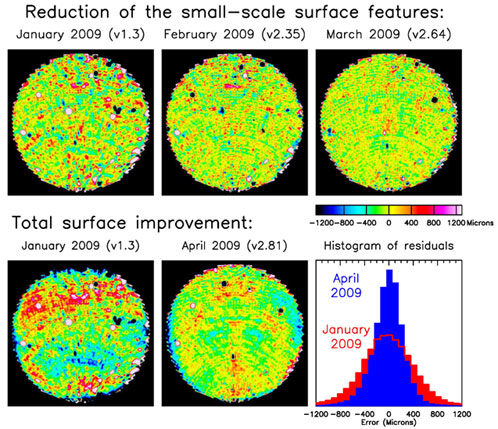Todd Hunter and Fred Schwab

Top row: Holography surface maps of the GBT, each of which has had the large-scale features removed. Top left: the initial surface as it was before any adjustments to the actuator table. Top center: after the first adjustment. Top right: after the second adjustment. Bottom left: the initial surface including large-scale features. Bottom center: the surface after the third adjustment. Bottom right: histogram showing the net improvement from January to April.
 Zoom
Zoom
The Precision Telescope Control System (PTCS) project team continues to improve the GBT surface accuracy using phase-coherent holography. In the February 2009 E-News, we reported a 40% increase in the 90 GHz sensitivity. We have since completed more iterations of surface measurements and corrections. The 90 GHz aperture efficiency is now factor of 2 higher than 2008 levels and is estimated to be 22%. Likewise, the Q-band efficiency has increased from 44% to ~51%. These improvements are consistent with a reduction of the total surface error from 390 to ~300 microns rms. According to the latest holography maps, the inner 56 meter diameter of the dish (one third of the total area) appears to have reached the goal of 210 microns rms. Improving the outer portion of the dish to this level is the next challenge.
In our initial iterations, we filtered out large-scale features in the holography maps in order to restrict our corrections to the small-scale errors. The top row of images in the Figure shows the progress made in reducing the small-scale errors from January to March. In early April, we averaged together two surface maps before deriving actuator corrections. We also corrected the large-scale features that have persisted in the maps, as demonstrated in the lower left image in the Figure. This technique yielded surface version 2.81 which became the default on April 10. The lower right panel of the Figure shows the improvement in the form of a histogram of the residual surface errors. The current best surface (v2.93) was installed on May 11 and tested with MUSTANG just prior to its removal from the GBT.
The holography receiver will remain on the telescope during the Summer months during which we plan to acquire more maps of the latest surface. Most of the maps recorded to date used a geostationary satellite located close to the highest possible elevation from Green Bank (45 deg). In the April 13th map shown, we successfully targeted a satellite at 22 degrees elevation. We will continue to explore the repeatability of the surface maps, determine how well the surface retains its figure, and try to produce additional corrections. Until MUSTANG returns to the telescope, we will use the Q-band receiver to gauge improvements and measure a new gain curve. Meanwhile, the maintenance team is fixing a few failed actuators identified from our maps. Additional information about PTCS projects is available at http://www.gb.nrao.edu/ptcs/.

 Zoom
Zoom